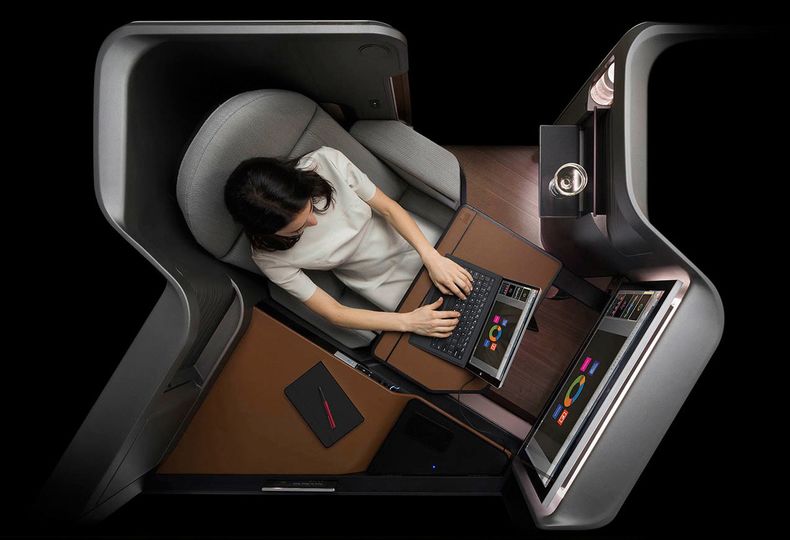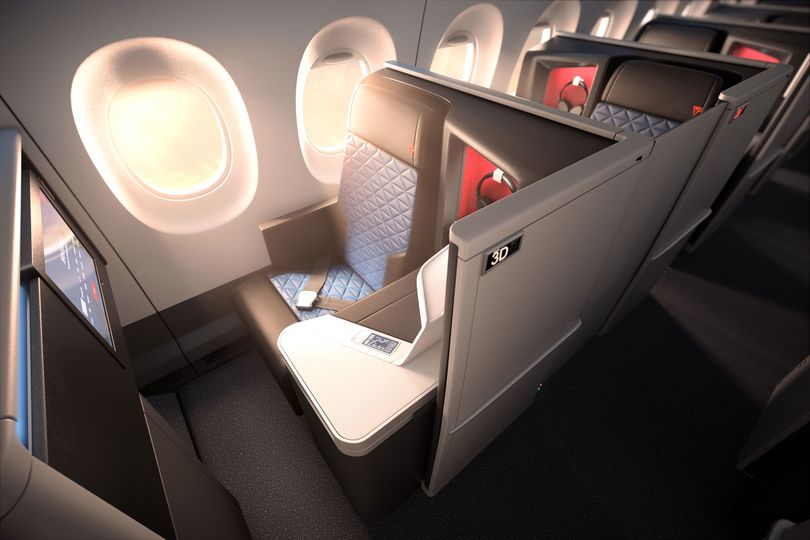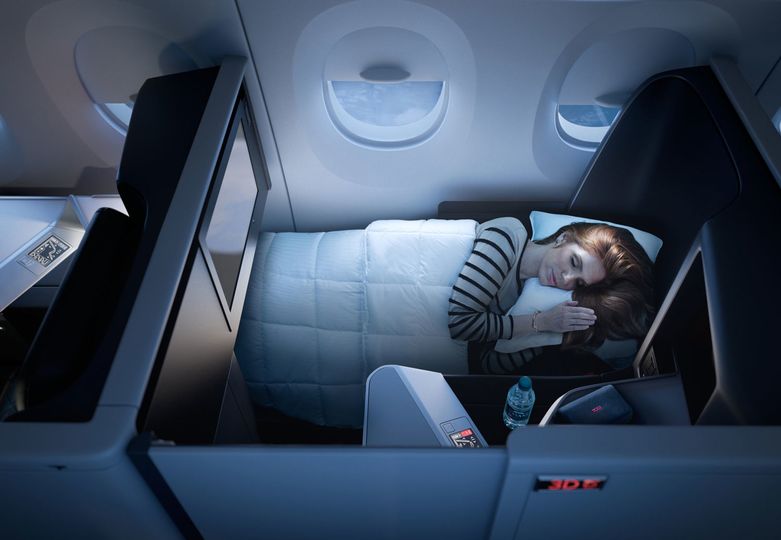High-tech, high-touch and privacy: the future of business class

While the vast majority of fliers are feeling the squeeze with tighter and tighter economy seats (we’re looking at you, American Airlines) and downright frightening customer-service disasters (United), we might well be witnessing the dawn of a new golden age of travel in the business-class section.
Now a standard fixture on most planes – both the jumbo jets that regularly traverse oceans as well as the single-aisle planes that make domestic short hops – business class first debuted a mere 40 years ago.
British Airways created a 'Club Class' between first and coach back in 1978, while Qantas coined the actual term 'business class' a year later.
The new first class
So where is business class heading now?
First off, it’s replacing first class on many airplanes and routes. It’s simply a less-expensive, less-expansive version of first class that still features lie-flat beds, multicourse menus created by celebrity chefs, and amenity kits stocked with spa products.
It makes sense for airlines: There are more seats and more fliers who can purchase these seats, thus more money to be made.
Second, the seats in business class are getting innovative updates – both technological and ergonomic – that should impact the flight experience in large and small ways.
And since airlines typically fly just a handful of aircraft types, you’ll see similar-looking seat styles across brands.
There will be uniformity in the improvements. It’s shockingly expensive (think millions of dollars and several years) to develop a new business-class product, so once risk-averse airlines find a style that works, they stick to it.
The focus now is on refining the use of space and new technology within each seat to maximize passenger comfort.
A high-tech revolution
One glimpse into what this future will look like already exists.
Though it won’t debut on commercial flights until 2019 at the earliest, the Waterfront seat was unveiled at the 2016 Consumer Electronics Show and is the result of a collaboration among seat manufacturer B/E Aerospace, design firms Teague and Formation Design Group, and technology giant Panasonic.
The physical seat is based on existing models from B/E, but Waterfront’s technology sets this iteration apart. The showpiece is a 24-inch, 4K ultrahigh-definition entertainment system, to which passengers will connect via an app on their smartphones or with a provided in-seat tablet.
Using their phones, passengers will be able to control everything: seat positioning (it reclines to a fully flat 79 inches), ambient lighting (there are more than 16 million possible settings), climate control of the seat’s various sectors, ordering meals and drinks, and creating entertainment playlists.
Passengers can illuminate a Do Not Disturb sign or set a wake-up call for the crew to rouse them based on when they want to rest.
The system will remember their preferences from flight to flight within an airline network, and their settings will automatically be available.
The entire point of the seat and all its technological bells and whistles is to allow passengers to tailor the entire flight experience to their individual inclinations.
Read more: Up close with the high-tech 'Waterfront' business class seat
Personalization is the wave of the future
While Waterfront and its technology are still a couple years off, airlines are already pursuing the same goal in other ways.
Matt Round, the chief creative officer of London-based design firm Tangerine, headed up the Virgin Australia business class redesign of both the seat and the inflight bar.
Round says his guiding principle was “delivering comfort, which is about the whole space, not just the seat, and is both physical and psychological. The seat must look comfortable, but the physical geometry of it will need to back up first impressions.”
So although the new seats are indeed spacious at 80 inches long, they also incorporate novel ergonomic features to give passengers a sense of control of their space.
A compartment containing power ports ingeniously includes a space between the top and the side so cords can remain out of sight while still connected to a laptop, leaving the seat uncluttered.
The tables slide back and forth so the passenger can adjust it to an ideal distance for work or dining.
There is also a discreet tablet holder in the seat so passengers can keep smaller devices with them for the whole flight, rather than retrieve belongings from their luggage after takeoff.
AusBT review: Virgin Australia 'The Business' business class seat
Privacy is still priceless
The blend of physical and psychological components is also evident in Qatar Airways’ new Qsuites, which the airline unveiled at ITB in Berlin earlier this year. The new seats possess up-to-the-minute features like closing doors and adjustable entertainment monitors.
However, the aspect that turned the most heads is that seats in the center of the cabin can be combined into private suites for meetings or meals, and some can be converted to double beds.
Gunter Saurwein, Qatar Airways’ vice president for the Americas, said, “Business-class travel has evolved into a singular activity, separating people from their traveling companions more and more. However, we identified the need for a more immersive product.”
To that end, Saurwein said, “the new Qsuite allows multiple configurations for passengers to tailor their in-flight experience to their specific needs.”
Read more: Qatar's Qsuite is a private 'business class bedroom'
Elements of customization and control were also the guiding directives behind Delta’s forthcoming business class suites, which fliers should start seeing on the airline’s new A350s later this year.
The suites have roughly the same dimensions as Delta’s current Delta One seats, but the major difference is that each will have its own closing door. “Customers first and foremost told us they wanted more privacy,” said Delta’s On-Board Product Manager Robbie Schaefer.
Thus closing doors, as well as higher walls and sliding privacy screens between center seats, all of which passengers can also leave open. “We want to make sure customers have privacy, but that they can choose how and when they want it,” said Schaefer.
The suites’ other improvements include new dedicated stowage spaces for personal items and more surface area, including an innovative two-tier shelf next to the seat where passengers can stow an electronic device.
Fliers should also notice high-tech touches including customizable ambient lighting, faster Wi-Fi thanks to 2Ku satellite connectivity, and a new in-flight entertainment system that they can watch on larger (18-inch) monitors.
The overall goal, according to Schaefer, “was to create a residential feel where customers have a spacious, private area that’s their own, whether they want to work, rest, relax, or dine.”
In other words, he said, “We wanted to design a product that puts control back in customers’ hands."













Qantas - Qantas Frequent Flyer
20 Mar 2014
Total posts 132
certainly exciting times for business! i do wish that first would hang around though...the space of first is always welcome. there are plenty of nice business seats, but they still feel cramped.
Qantas - Qantas Frequent Flyer
29 Mar 2015
Total posts 94
I agree with turbojezz; i would have thought that there would always be a market for space, and space being the big difference between the new hi tech J, and the spacious F.
01 Mar 2017
Total posts 9
so sad QatarAir is 'banned' at present. they've always had the most innovative Biz class going around. my wife and I have many pleasant experiences flying with them over the years.
Singapore Airlines - KrisFlyer
14 Jan 2014
Total posts 340
07 Jun 2016
Total posts 29
Am I the only one who dislikes the idea of having to use my own phone to control the seat and IFE? Please install a good touch screen controler as factory default and offer me the real luxury of being able to store my phone away for the entirety of the flight. Else, where will this end? A phone app for flushing the lavatory?
27 May 2015
Total posts 23
I agree. I'm a gadget nut, but I would still prefer the seat to include its own control, whether a tablet or a wired remote - something with its own dedicated home.
BA
31 Mar 2014
Total posts 23
The problem I have found with 'new' generation J seats is that, in bed mode, your feet often wind up in a very narrow space. For example, on the DOH - SYD route, compare the footwell space of the current QR A380 with the space available in bed mode on the old QR 777ER and you will see what I mean. Yes, the QR 777ER did not have aisle access for each J seat being a 2-2-2 config but bed mode to me means the ability to sleep on a 14 hour flight, not waking up everytime I move due to a confined footwell like my last A380 experience.
Is this just me or do other J users have similar views. I do prefer 1-2-1 but surely having 1-2-1 with a footwell as wide as the seat is not that difficult.
26 Jul 2015
Total posts 80
It is all about the space for your feet to me. I hate the tiny little footwell space for my size 12's. All the other bell's and whistles are nice, but if the feet aren't comfortable, its a dud flight.
Qantas - Qantas Frequent Flyer
27 Oct 2016
Total posts 2
We flew British Airways during 2010 in a "double" business class suite very similar to the Qatar Airways new Qsuites. Great for travelling companions with space and privacy, best business class experience ever. Just returned from Japan in those horrible Qantas A330 business seats playing hide & seek with my partner who could not find a way to adjust the sash seat belt (nor could the steward) and struggling to find a comfortable recline position to watch a movie.
Qantas - Qantas Frequent Flyer
08 Jun 2017
Total posts 1
Wonder how long before the big, open, lay flat business class seats on Qantas A380 and Qatar 777 are 'new' again.
I love the feeling of space these older arrangements have vs the claustrophobic, closed-in, fox-holes in the current 'new' designs.
01 Mar 2017
Total posts 9
after many years of Biz Flying, I now only ever go with the flag carrier of the country to I wish to fly. free upgrades to business or better, plus all the perks that go with it. no eco airlines or 'best fares for business'. my exception is QF. they've sold their soul. my preference to Europe is SQ. hands down the best Airline in the world.
01 Mar 2017
Total posts 9
correction - to *which* I wish to fly.
Hi Guest, join in the discussion on High-tech, high-touch and privacy: the future of business class